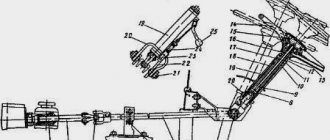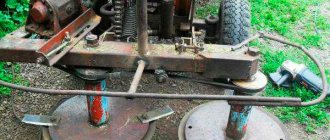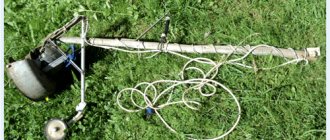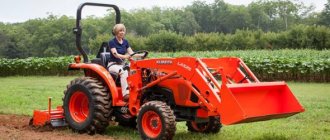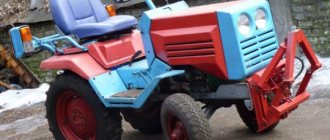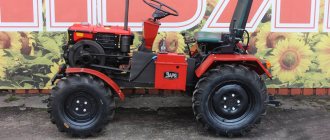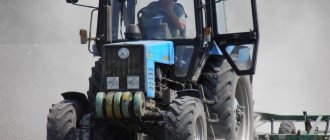Not everyone can afford to buy compact agricultural machinery. But assembling a minitractor from the Oka is available to anyone who has the skills to work with metal and understands the structure of cars. Craftsmen have developed many original designs that are easy to make at home using the parts available.
What do you need to work
In the presence of a dismantled or emergency Oka car, the master can use its surviving units:
- engine;
- transmission;
- wheel axles;
- steering.
If necessary, these nodes are replaced with compatible ones, modifying the junctions of different units.
Do-it-yourself tractor from Oka is made on the basis of a channel No. 6-8 or a corner 4x4 cm. The amount of material is easy to calculate based on the diagrams where the frame dimensions are indicated.
In addition to these, you will need the following tools and materials:
- Bulgarian;
- welding machine;
- a set of auto repair tools;
- sheet metal;
- spare parts from Oka or other cars;
- tires and wheels of large diameter (13-24 inches, depending on the use of the technical tool).
As a seat for a homemade tractor with an engine from Oka, you can use any object suitable for this purpose. There are even designs with a stool fixed to the frame or an office chair removed from the support.
Tools and fixtures - what you need for work
The cab for MTZ tractors is made in a single-seat variation with a steel frame made of pipes. For its manufacture, you should take care of the following in advance:
- Spacious room with a total area of about 30-40 sq.m;
- Wooden bars 1.6x6 cm;
- Steel pipes or profile;
- Glass (front, rear and side);
- Sheets of steel 1.2-2 mm thick;
- Welder;
- Bulgarian or hacksaw;
- Power tool set;
- Joinery and carpentry tools;
- Self-tapping screws, bolts and other fasteners.
How to make a frame for a mini tractor
2 types of mini-equipment are known, differing in frame design:
- Both the Oka engine and the driver's seat are located on a single platform. Such a frame can be assembled in the form of a rectangle from a channel. When using a 4x4 cm corner, you need to weld a pipe with a square section from a profile, and use them for work, because the material itself is not strong enough to withstand the weight of the engine and the driver. The frame spars can be made straight or stepped. To connect the side parts of the frame, front and rear traverses are used, as well as transverse beams reinforcing the structure under the engine (2 pcs.) And the seat.
- When using a breaking frame (break tractor), the master must assemble the front and rear half frames, and then connect them with a hinge. It is convenient to use the trunnion and bearings from KamAZ: the cardan system allows the semi-frames to move in horizontal and vertical planes. This is a more complex design that will require finding additional transmission parts. But a homemade tractor from the Oka will turn out to be more maneuverable. When making a break, you need to take into account that the front part must be of sufficient size to accommodate the engine, gearbox and steering. Only the seat is installed on the rear half-frame. Each semi-frame carries 1 pair of wheels.
In order to correctly calculate the dimensions of the frame, you need to independently make drawings, on which you indicate the location of all structural nodes. After that, you can proceed to the manufacture of the base for the mini-tractor. When assembling, it is desirable to use welds to provide the frame with sufficient strength. On the rear traverse, install a mount for mounted implements.
How to assemble a tractor
To mount tractor units on the frame, you will need the ability to select spare parts from other mechanisms. When assembling, the master must carry out the following stages of work:
- installation of the undercarriage based on wheels or tracks;
- engine and clutch installation;
- creation of braking and steering systems;
- seat fastening.
To install the wheel axle shafts on the frame from below, weld the racks from the corner. It is better to take the same type of front and rear axles, this will greatly facilitate other tasks. When using bridges from Oka, it may be necessary to replace the hubs to install larger diameter discs. Sometimes craftsmen make it easier: they cut out a circle with a mount from the Oka rim and weld it into a hole prepared on the rim from another car.
It is better to make the front axle for a break on your own, from a steel bar with a thickness of at least 5 cm. In the middle of the part, you need to install a swivel joint, which will ensure the mobility of the bridge on uneven roads. Equip the ends of the homemade beam with ears for attaching axle shafts with hubs. To lubricate the system, install a separate oil tank. The distributor for front-wheel drive cars or tractors Belarus will help make these wheels drive.
When creating a do-it-yourself mini tractor with an Oka engine, the easiest way is to use standard brakes and clutch. On a one-piece frame, this part of the assembly should not cause any problems, especially when using bridges from the same car. Only the problem of placing the engine itself is solved individually. This large unit is most often installed in front, but the craftsmen, concerned about the compactness of the tractor, move the motor back, under the driver's seat.
When working with a breaking frame and a homemade front axle, parts from other cars can be used. In this case, they are customized to fit the existing designs. When manufacturing a caterpillar tractor, you will need to purchase tracks and rollers for them, which will greatly complicate the work.
On a home-made minitractor with an engine from Oka, they put a gearbox from the same car. At a fracture, the unit is mounted on the front half-frame. When using a solid base for homemade, the gearbox is placed in a convenient place, turning towards the driver.
Steering involves a standard procedure for installing rods suitable for the undercarriage used in the design. As a steering column, both the assembly from Oka and the corresponding part of the motorcycle are used.
Minitractor from a walk-behind tractor. Modules for common models
In the article Snowmobile from a walk-behind tractor. More versatile and cheaper than a motorized towing vehicle
modules for a walk-behind tractor were shown, which turn it into an analogue of a motorized towing vehicle, into a motorized dog.
It turns out that there are a number of modules for a walk-behind tractor. In this article, I propose to look at the module for the walk-behind tractor, which turns it into a mini tractor:
Module KV-2 for motoblocks Agat and Solut. Weight 50 kg. This module is not suitable for other walk-behind tractors. Or you need to redo the mount.
Design in detail. As you can see, the front wheels are wider than the wheels of the walk-behind tractor. The track width of the front axle is 106 cm. This gives increased stability for the minitractor, there is no risk of it turning over. Two ball bearings per hub. Brakes - drum, driven through a cable mounted on the pedal. The second pedal - belt tension, clutch. Simple steering rack with adjustable rods.
Photo while driving to understand the size of the module. Dual wheels can be installed on the walk-behind tractor itself. The wheels, by the way, are suitable from VAZ classics. By installing them, the ground clearance will increase and the minitractor can be used for riding on forest roads.
The cost of this KV-2 module is 21 thousand rubles. More details: https://www.gardenstock.ru/catalog/motobloki-i-kultivatory/telegi-pricepy-ezdovye_adaptery/kadvi-komponovochnyy-modul-kv-2
What is this module for?
You can pull a trailer, install a snow plow. You can install milling cutters instead of the wheels of a walk-behind tractor and plow the garden, sitting on it as a weighting agent. It's better than running after a walk-behind tractor.
A brief overview of this module in the video:
An overview of this module on VAZ wheels is here:
Tractor module for other common models of walk-behind tractors - Neva, Oka, Salyut, MK-900, MS-680, Brait and their other modifications such as MB:
The design is similar to the KV-2, only the blade attachment with a lifting mechanism is included. The track width is 700 mm, which is less than that of the KV-2 and the minitractor is less stable on slopes. Weight 75 kg. Turning radius - 3 m.
The cost of this module is 27 thousand rubles. I don't know why it's more expensive, maybe just because it's from a different manufacturer. Both modules are made in Russia. Read more: https://www.gardenstock.ru/catalog/motobloki-i-kultivatory/telegi-pricepy-ezdovye_adaptery/modul-pereoborudovaniya-mt-1-moto-traktor-dlya-motoblokov-neva-hoper-900
An overview of the module is here:
Also, a mower can be installed on this module. For summer haymaking in the countryside, a relevant option. We will talk about a mower for a walk-behind tractor and other attachments in the next article. Therefore, subscribe to the channel so as not to miss those who are interested in this topic.
Design and comfort
To mount this part of the structure, it is necessary to make a solid base from the corners welded vertically to the frame. A homemade mini tractor with an Oka engine is most often made without springs, so the shocks during movement will be very noticeable.
For human safety during prolonged work and to reduce the vibration load on the spine, it is necessary to install soft springs under the seat.
Work or movement in the dark will also require the installation of lighting devices, i.e., the installation of electrical wiring and headlights. When using a tractor in a summer cottage, this is not necessary, but can be used to decorate an agricultural machine.
An old Oka in good technical condition can be adapted as a draft force by cutting off a part of the body at the back and equipping it with attachments. But the emergency car will have to be used in parts, creating a completely new mechanism on its basis.

